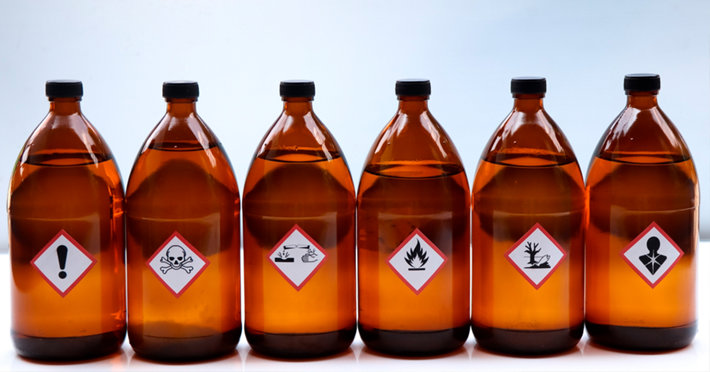How Inhalants Can Kill, Even the Very First Time They Are Used

The abuse of inhalants is most prevalent among young people, in large part because these substances are universally available. A young teen or even pre-teen may hear exciting stories about the intoxication available from these substances and seek them out around their home, garage, or even classroom. When they get a few moments alone or with friends who want to engage in the same dangerous activity, they then experiment with these substances. They have no idea that these inhalants can kill them the first time they try them.
It seems so harmless—just a little drunken intoxication from inhaling the fumes of ordinary household objects. There’s not even any easy way to prevent their abuse—they are in every home and garage.
The most popular items used for this purpose are felt tip pens and markers. These items are found in nearly every student’s room, so it’s no surprise they are the most popular types of inhalants.
Other items misused in this way (in order of popularity):
- Glue, shoe polish, or toluene (solvent found in paint thinner or nail polish remover)
- Spray paints
- Gasoline or lighter fluid
- Computer duster
- Correction or cleaning fluid
- Paint solvent
- Amyl nitrate, poppers
- Nitrous oxide, whippets
- Lighter fluids such as butane or propane
- Ether or other anesthetic
- Other types of aerosol sprays
In the average home, there are dozens or even hundreds of abusable substances. They appear in the form of deodorants, cooking sprays, household cleaners, Super Glue, insecticides, spray lubricants, air fresheners, mothballs, flat tire repair aerosols, degreasers, oven cleaners, spot removers, whipped cream cans, and many, many others.
How Are These Substances Abused?
- They can be directly inhaled simply by putting the substance under the nose and inhaling or spraying it into the nose or mouth.
- Some users will spray or place the substance inside a plastic or paper bag and then place the bag’s opening over the face. This is called “bagging.”
- “Huffing” consists of either soaking a rag in a liquid and then placing it over the nose and mouth or inhaling the gases from nitrous oxide-filled balloons.
Who Abuses These Substances and How Often?

According to the Centers for Disease Control and Prevention, one in twelve high school students reported the use of inhalants at some point in their lives. Girls were actually more likely to misuse an inhalant than boys. More than 9% of girls said they had ever misused an inhalant, compared to less than 7% of boys. This varies from the norm for substance abuse since young males more commonly abuse nearly every other substance than young females.
While most types of substance abuse decreased during the pandemic years, inhalant abuse increased—another way inhalant abuse differs from the norm.
Inhalant abuse is also more common in younger children and lessens as these adolescents age. In general, the abuse of any specific substance becomes more likely as a child gets older, but that’s not the case with inhalants.
These substances are highly available and cheap (or free, since they are often in the home). As a young person ages, they are more able to find supplies of drugs like marijuana, pharmaceuticals, or alcohol, and they have the money to buy them. At that point, their interests change, and most people abandon inhalant abuse. Of course, some adults become addicted to inhalants and keep abusing them until they get help.
Statistics from the Annual Monitoring the Future Survey
According to the 2022 Monitoring the Future survey of 8th, 10th, and 12th grade students in 2021:
- Eighth-grade students who abused an inhalant in the last year: 3.6%
- Tenth-grade students: 2.4%
- Twelfth-grade students: 1.8%
The Monitoring the Future survey also lets us know that the use of inhalants by these students was not particularly frequent, which is fortunate. Most students only abuse these substances once or twice a month. Few went on to abuse them on 3 to 5 occasions in the last month, and fewer still used them six or more times. However, it could only take one use to kill a young person.
Seven-tenths of one percent of eighth-grade students said they abused inhalants “40 or more times” in the past 30 days. This works out nationally to 2,700 eighth-grade students who are taking their lives in their hands every day because of their addiction to inhalants. And their parents probably have no idea. That’s just because it seems to be inherent in any drug use that the user conceals their actions.
It’s estimated that 160,000 adolescents initiate inhalant abuse each year. Also, the Substance Abuse and Mental Health Services Administration reports the total number of people misusing these substances: in 2021, more than 2.2 million people aged 12 and older abused an inhalant. An estimated 22.5 million Americans have abused an inhalant at least once in their lifetime.
How Inhalants Kill
When a doctor tries to save the life of a person who has been abusing inhalants, they have to determine what kind of damage has been created. Recent medical research has identified the different pathways to death after the use of these toxic chemicals.

There are four primary pathways to sudden death:
- Inhalation of hydrocarbons (gasoline, benzene, toluene, and others) can trigger the release of catecholamine—a neurotransmitter that controls many central nervous system processes. High levels of catecholamine can cause heart damage, even in a person with a healthy heart. The result can be an arrhythmia (irregular heartbeat) that causes cardiac arrest.
- Many inhalants have an intense cooling effect. When they are inhaled, they can cause a severe cooling injury to the mouth, throat, and larynx. The body may respond by drastically lowering the heart rate, which can also cause an arrhythmia with death as the outcome.
- Hypoxia refers to a lack of sufficient oxygen. It is quite possible to die from hypoxia, a lack of oxygen serious enough to cause death. This can happen if a person places a bag over their head while trying to inhale gases or if the concentration of gases they inhaled is sufficient to replace all the oxygen in their lungs. Some people also choke, vomit, and then inhale the vomited material, also causing hypoxia.
- Another common cause of inhalant-related death is an accident. An impaired person may fall because of their poor judgment or perception. Inhalant materials are also highly flammable, and it’s possible for them to catch on fire. The abuser may then die from burns to the face and airway. Some people also die from auto accidents resulting from their impairment.
More Than One Thousand Deaths from Just One Type of Inhalant
Just one type of inhalant, aerosol dusters, killed 1,115 people between 2006 and 2022. An additional 28,800 emergency room visits involving inhalation injuries were required after abuse of this common household item.
Harmful Non-Fatal Effects
Even if these substances do not kill the abuser, there are minor and major injuries that can be created, such as:
- Injury to the upper airway due to the cold
- Lung inflammation
- Liver and kidney toxicity
- Hearing and vision loss
- Loss of balance and coordination
- Loss of sensation
- Blackouts
- Leukemia
- Impaired immunity
- Heart inflammation and damage
- Brain damage resulting in headache, dizziness, nausea, vomiting, and fatigue
Some of these effects may resolve if inhalant abuse stops, but some effects can be permanent. Brain damage, for example, may be permanent.
Detecting Inhalant Abuse
How can a parent or caregiver tell if a young person (or one who is not so young) is abusing inhalants? Look for the following signs:
- Red eyes or nose
- Slurring their speech
- Paint or oily stains on body or clothes
- Rags or paper or plastic bags with chemical smells or stains
- Sores around the mouth or nose
- Appears to be drunk
- Dizzy or dazed
- Nauseated
- Lack of appetite
- Depressed, anxious, argumentative
- Empty containers of paint, solvent, computer duster, or other inhalant
When you see a few or several of these signs, it’s time to look much more closely at the young person’s health and behavior.
Stopping Inhalant Abuse

Young people must be warned of the permanent damage that can occur from even one misuse of an inhalant. Teens and pre-teens must also learn very early, before they ever give inhalants a try, that there is the possibility of death the first time they misuse one.
Many young people are going to hear about how fun and exciting inhalant abuse is from friends, and some will be tempted to look for these readily available items. Every parent needs to consider that their child might reach for one of the dozens or even hundreds of inhalants around the house so they can experience that intoxication for themselves. No child is immune. Every parent should take action to educate their children carefully and thoroughly on the life-threatening dangers of these toxic chemicals.
Sources:
- “Alcohol and Other Substance Use Before and During the COVID-19 Pandemic Among High School Students.” Centers for Disease Control and Prevention, 2023. CDC
- “What is the scope of inhalant use in the United States?” National Institute on Drug Abuse, 2022. NIDA
- “Monitoring the Future.” https://monitoringthefuture.org/wp-content/uploads/2022/08/mtf-vol1_2021.pdf
- “Key Substance Use and Mental Health Indicators in the United States.” Substance Abuse and Mental Health Services Administration, 2021. SAMHSA
- “Inhalant Use and Inhalant Use Disorders in the United States.” National Library of Medicine, 2011. NLM
- “The Clinical Assessment and Treatment of Inhalant Abuse.” National Library of Medicine, 2023. NLM
- “CPSC Grants Petition for Federal Rule to End Huffing Deaths from Aerosol Dusters.” Consumer Product Safety Administration, 2023. CPSA
- “A Parent’s Guide to Inhalant Abuse.” Stanford Medicine, 2023. Stanford


 ®
®